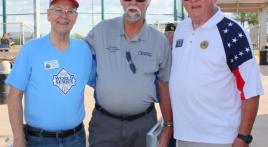The proud history of Destroyer Escorts started during WWI to protect convoys from enemy attack. Ford Motor Company was awarded the contract to build the engines for these DE’s, but none of these ships were completed in time for war service. They were commissioned into US Coast Guard service. As the war in Europe started to escalate in the 1930’s, the Royal Navy recognized the need to mass produce destroyer vessels to protect Atlantic convoys from U-Boat attacks. The United States developed a plan to build destroyer escorts for the Royal Navy with lend-lease funds keeping us out of the war. This all changed on December 7, 1941 with the Japanese attack on Pearl Harbor. The United States faced the same critical need for escort vessels to protect our troops and cargo ships crossing the Atlantic. The bulk of existing Destroyer Escorts were pressed into US Navy service. To meet the critical need for these ships, fabrication of sections were manufactured many miles from the shipyard. Between February 1943 and September 1945, 563 Destroyer Escorts were commissioned in about 32 months.
USS Slater DE766 was built by the Tampa Shipbuilding Company and launched on February 13, 1944. She was named after Frank O. Slater from Fyffe, Alabama. Frank was born in 1920 as one of twelve children of a sharecropper family from Kennamer Cove Valley. He enlisted in the US Navy February 1942, and after his basic training he was assigned to the USS San Francisco CA38 where he served for 8 months. On November 12, 1942, Frank displayed extraordinary heroism as a gunner against enemy Japanese forces in the Solomon Islands. He refused to give up his gun station against the onrushing Japanese torpedo planes. Seaman Second Class Slater kept blazing until a hostile flaming craft crashed on his duty station earning him the Navy Cross. Frank O. Slater was buried at sea; there is a stone in Arlington National Cemetery in his memory. When the USS Slater was launched in 1944, fourteen members of his family traveled to Florida for this event.
This cannon class destroyer was equipped with three 3”/50 cal. gun mounts, two 20mm anti-aircraft guns, three 21 inch torpedo tubes, eight depth charge projectors, two depth charge racks and one hedgehog rack. This ship was fully equipped for anti-submarine warfare. The Slater was propelled by four General Motors model 16-287A decal engines and could reach up to 21 knots, equipped with sonar and radar making it a perfect war ship. The USS Slater was commissioned May 1, 1944 with a crew of 15 officers and 201 enlisted men. After her shakedown cruise, she was called to Norfolk to deliver a torpedo captured from German U-boat 505. During the following year, the Slater made ten stormy crossings escorting convoys through U-boat infested waters to England and Wales. As the battle of the Atlantic drew to a conclusion, the Slater underwent modifications in her armament for battling kamikaze aircraft that took a heavy toll on US and Allied vessels in the Pacific Theater. Her arrival in the Pacific coincided with the dropping of the atomic bombs on the mainland of Japan. The Slater was part of the Task Unit 33.2.4 occupation duty at Manila escorting convoys to Japan, Biak, the West Indies and Carolina Islands. January 1946 the Slater returned to Norfolk and was de- commissioned February 1947 and put in the mothball fleet.
On March 1, 1951 The USS Slater was transferred to the Hellenic Navy in Greece and renamed AETOS (Eagle) under the Mutual Defense Assistance Program assisting NATO allies in escorting convoy vessels using antisubmarine warfare against the threat of Communist bloc invasion of Western Europe. During the AETOS service in the Greek Navy, she completed more than 3,223 voyages for cadet training, patrols, exercises and independent mission sailing over 617,876 nautical miles. The AETOS played a key role in the movie “Guns of Navarone”. The Greek Navy deactivated AETOS on July 5, 1991, stripped it for parts and made it ready to scrap.
Destroyer Escorts served the US Navy from WWII, Korea, Vietnam, and the Cold War. In the1980’s they were decommissioned, scrapped, and given to allied Navies, with a small number of these ships being converted to Frigates and equipped with the latest technology.
The Destroyer Escort Sailors Association was founded in 1975 by Frank Crawford a Sonarman from Knoxville, Tennessee. Frank, who served on the USS Lewis DE535 and the Earl K. Olson DE765, knew the DE veterans were growing older, more nostalgic, and may have felt that history has overlooked their service. Frank surmised that crews from the 563 Destroyer Escorts built during WWII would support his association. He emphasized that DESA would be a “Last Man” association existing to sponsor ship crew reunions and hold a national convention. From WWII through the Cold War, it was estimated that 150,000 men served on these ships, including the seventy-eight turned over to the British Royal Navy. Frank could have never imagined the growth of this organization from state chapters to national membership with an active and dynamic Ladies Auxiliary who are a great asset to the Association We know the price of freedom is not free and at each National Convention we hold a Memorial Service to remember the sixteen US Navy Destroyer Escorts damaged or sunk and the 857 sailors who lost their lives. We also remember the sailors who lost their lives serving aboard the seventeen Royal Navy Destroyer Escorts that were lost at sea.
Something was missing for many of these old sailors. At their 1992 convention in Buffalo, NY the membership charged the officers to find a DE for a museum. They needed a tangible piece of their service to show to the rest of the world. In 1993 the Board of Directors voted to establish a new not-for- profit educational organization called the Destroyer Escort Historical Foundation. They found the Greek Navy ship AETOS stripped of all usable parts in Souda Bay, Crete ready for disposal. After a year of negotiations through the State Department, the Greek Navy agreed to donate the ex USS Slater to the Museum. They raised $290.000 to have the Slater towed across the ocean to New York City and berthed next to the Aircraft Carrier USS Intrepid. Local volunteers started the enormous restoration project. This work continued on a large scale when the USS Slater DE776 was moved to its permanent quarters in Albany, New York. This ship became a historical museum for display of many DE sailors’ treasurers, and in 2001 was granted museum status by the New York State Department of Education followed by an Absolute Charter in 2011. After nineteen years of dedication of thousands of volunteer hours and unbelievable financial support, the United States Department of Interior in 2012 designated the USS Slater as a National Historical Landmark.
The final area our volunteers were unable to do was to repair the hull. A fund drive took many years to come up with a little over a million dollars which was a little short of the cost of restoration in dry dock. Unable to delay any longer, the board made this decision. She was towed to Caddell Shipyard dry dock #6 in Staten Island for a twelve week overhaul. While in dry dock, the membership added another $400,000 to the fund to allow a lot of additional work to be completed in dry dock. With its WWII camouflage paint, the USS Slater DE766 proudly returned to its home port in Albany in mid- June 2014 as a true example of the proud heritage of all DE’s that served this Great Nation and the British Royal Navy. The hull restoration project has insured this piece of Naval history will be a museum for many generations.
Destroyer Escort Sailors Association – WEB SITE : http://www.desausa.org
Destroyer Escort Historical Museum – WEBSITE : www.ussslater.org




